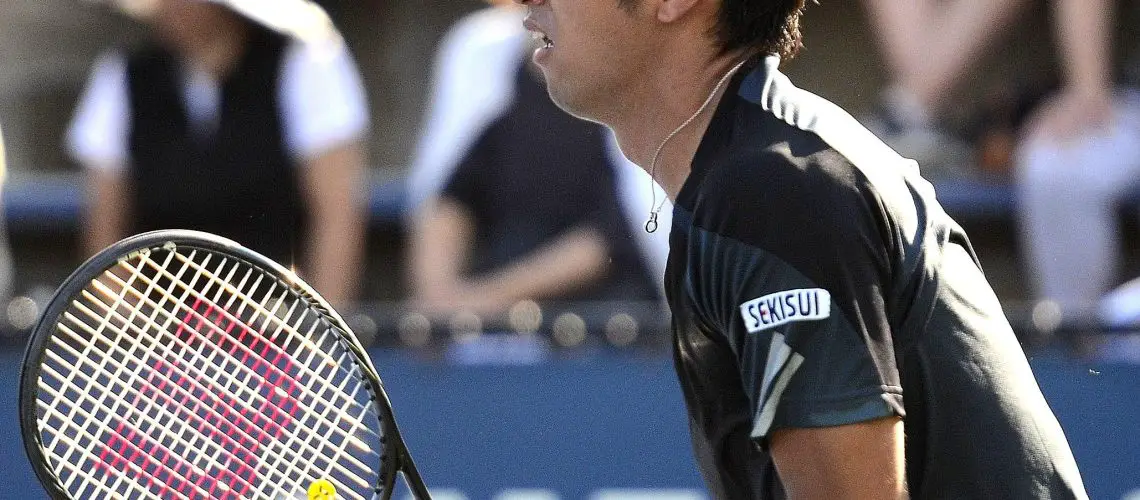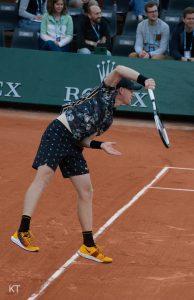We may earn money or products from the companies mentioned in this post.
Doubles Tennis: Mastering the Art of Teamwork

In the world of tennis, doubles matches bring a unique set of challenges and opportunities While singles tennis is often seen as an individual sport, doubles requires players to work together as a cohesive unit The importance of teamwork and communication cannot be overstated in this format
The Power of Teamwork and Communication
When playing doubles tennis, it’s crucial to establish effective communication with your partner right from the start Clear and concise communication allows you to anticipate each other’s moves, coordinate strategies, and react swiftly to your opponents’ shots By working together as a team, you can cover more ground on the court and exploit your opponents’ weaknesses
Teamwork also involves understanding each other’s strengths and weaknesses By identifying your partner’s skills, you can develop strategies that maximize their strengths while minimizing their weaknesses This level of understanding can lead to a harmonious partnership that can be hard for opponents to break down
Navigating Challenges When Playing with a Weak Partner
Playing doubles with a weak partner may present some challenges, but it doesn’t mean victory is out of reach Instead of focusing on their limitations, concentrate on how you can support them and help elevate their game
1 Play to Their Strengths:
Every player has something they excel at Identify your partner’s strengths—whether it’s serving accuracy or volleying skills—and strategize accordingly By putting them in positions where they feel comfortable, you enhance their confidence and enable them to contribute positively to the match
2 Cover More Ground:
With a weaker partner, it becomes even more important for you to cover more ground on the court Be proactive in moving towards balls that seem out of reach for your partner, and be prepared to make split-second decisions on shot selection By taking on a larger share of the court, you can compensate for any weaknesses in your partner’s game
3 Encourage and Motivate:
Tennis is as much a mental game as it is physical Keep your partner motivated throughout the match by offering words of encouragement and support Celebrate their successes, no matter how small, and help them stay focused even during challenging moments
Tips and Strategies for Winning with a Weak Partner

-
Develop Strong Communication:
Establish clear signals or code words that indicate certain strategies or shots to be executed This will help prevent confusion during fast-paced rallies -
Create Space:
When playing against stronger opponents, it’s essential to create space between your team and exploit gaps in their positioning Use lobs, drop shots, or angled shots to force opponents out of position -
Mix Up Your Shots:
Varying your shot selection can keep opponents guessing and disrupt their rhythm Experiment with different angles, speeds, and spin to keep them off balance -
Cover Weak Areas:
Identify areas where your weak partner struggles the most and be prepared to cover those zones when necessary This ensures that no part of the court is left exposed for easy winners by your opponents
In conclusion,
Assessing Your Partner’s Strengths and Weaknesses

In the game of tennis, having a strong doubles partner can make all the difference in achieving victory on the court Understanding your partner’s strengths and weaknesses is crucial for developing effective strategies and maximizing your chances of success Let’s dive into how you can assess your partner’s abilities to build a winning team
Identifying areas where your partner excels
Every player has their own unique set of skills that they bring to the table By identifying these strengths, you can leverage them to your advantage during matches Here are a few key areas to look out for:
-
Serve technique:
A powerful and accurate serve is an invaluable asset in doubles tennis If your partner has a strong serving technique, it can put pressure on the opponents right from the start of each point -
Forehand or backhand strength:
Assess whether your partner excels at hitting forehand or backhand shots with precision and power This will help you determine which side of the court they should cover more often -
Quick reflexes at the net:
The ability to react swiftly at the net is crucial for intercepting volleys and putting away winning shots If your partner demonstrates quick reflexes, it can create opportunities for aggressive play near the net
Recognizing your partner’s weaknesses
No player is perfect, and it’s important to be aware of areas where your partner may struggle Recognizing their weaknesses allows you to adjust your gameplay accordingly and provide support when needed Consider these potential weaknesses:
-
Limited mobility or speed:
If your partner lacks mobility or speed, it may be necessary to cover more ground on the court and take on a larger share of defensive responsibilities -
Inconsistent groundstrokes:
Inconsistency with groundstrokes can lead to unforced errors and give opponents an advantage Recognize any weaknesses in your partner’s ground game so you can work together to minimize errors and maintain consistency -
Poor volleys or overhead shots:
Not everyone excels at volleying or executing overhead shots If your partner struggles in these areas, focus on improving their technique through practice and provide assistance when necessary during matches
The importance of honest communication with your partner
To truly harness the strengths of your partnership and address weaknesses effectively, open and honest communication is key Discussing each other’s strengths and weaknesses allows you to develop strategies that play to your strengths while mitigating vulnerabilities By openly communicating with your partner, you can create a strong bond built on trust, understanding, and mutual support
Remember, assessing your partner’s strengths and weaknesses is not about criticizing or blaming but rather about working together as a cohesive unit Embrace the differences in skill sets and use them to complement each other’s abilities With an honest assessment of each other’s capabilities, you’ll be well-equipped to conquer the tennis court as a dynamic doubles team!
Strategies and Tips For Overcoming Weaknesses

Positioning on the court to maximize strengths and minimize weaknesses
In tennis, positioning plays a crucial role in optimizing your gameplay One effective strategy is the Australian formation, which can be utilized to protect weaker players at the net By having the stronger player cover more ground at the front, it minimizes vulnerability while allowing the weaker player to focus on their strengths Another useful tactic is the I-formation during serves This formation helps reduce pressure on the weaker player by creating confusion for opponents and forcing them to adjust their shots
Adapting gameplay based on your opponents’ tactics
Adapting your gameplay according to your opponents’ tactics is a key aspect of overcoming weaknesses By carefully observing and analyzing their playstyle, you can identify their weaknesses and exploit them while safeguarding your own vulnerabilities Additionally, recognizing patterns in their shots can give you an edge by allowing you to anticipate where they will hit next
Communication and teamwork as key components to success
Tennis is not just an individual sport; it requires effective communication and teamwork with your partner or teammates Encouraging positive reinforcement between partners boosts morale and enhances performance on the court Regularly discussing tactics, strategies, and making adjustments during breaks fosters better coordination and ensures that everyone is on the same page
Training Together To Improve As A Team

A . Practicing specific drills tailored towards improving weaknesses
To overcome weaknesses as a team, it’s essential to design practice drills that target specific areas of improvement For example, focusing on groundstroke consistency exercises allows players to enhance their control over shots from baseline rallies Additionally, incorporating volley practice sessions helps improve net play and strengthens the weaker player’s skills in that area
Building trust and chemistry through off-court activities
Building trust and chemistry among team members is a vital aspect of success on the court Engaging in off-court activities such as team-building exercises like trust falls or team relay races fosters a sense of unity and cooperation Socializing together outside of practice sessions also strengthens the bond between teammates, leading to better understanding and coordination during matches
Setting realistic goals and celebrating progress
Setting realistic goals for both individual players and the team as a whole is crucial for growth By tracking improvements in gameplay over time, you can recognize the progress made by each player Acknowledging and rewarding achievements as a team further motivates everyone to continue working hard towards overcoming weaknesses collectively
Conclusion

As we wrap up our discussion on winning with a weak partner, let’s recap the main strategies that can help you turn the odds in your favor Remember, it’s not about finding fault or assigning blame but rather about finding ways to overcome challenges and achieve success together
Recap of the main strategies for winning with a weak partner
The first key strategy is effective communication Openly discussing strengths, weaknesses, and goals will allow you to align your efforts and make informed decisions Clear and honest communication builds trust and fosters collaboration, enabling you to find creative solutions even in challenging situations
The second strategy is emphasizing teamwork By working together, leveraging each other’s strengths, and supporting one another through difficulties, you can create a strong bond that drives success Remember that every team member has something valuable to contribute, regardless of their individual skill level
The third strategy is prioritizing continuous improvement Rather than dwelling on past mistakes or limitations, focus on learning and growing as a team Encourage your partner to develop their skills by providing constructive feedback and offering resources for improvement By continuously honing your abilities together, you’ll increase your chances of achieving victory
Emphasis on communication, teamwork, and continuous improvement
Communication, teamwork, and continuous improvement are the pillars that will help you navigate the challenges of playing with a weak partner effectively Without these elements in place, it becomes increasingly difficult to adapt to different scenarios or overcome setbacks
Effective communication ensures that everyone is on the same page while fostering an environment where all voices are heard and valued Teamwork brings individuals together towards a common goal while cultivating synergy that amplifies success beyond individual capabilities Continuous improvement pushes both yourself and your partner to grow personally and as a team, enabling you to face any challenge with resilience and determination
Encouragement to stay positive and enjoy the game
Lastly, it’s essential to maintain a positive mindset and enjoy the game Remember that winning isn’t everything; the journey itself holds immense value Celebrate small victories, learn from defeats, and embrace the joy of playing together By fostering a positive atmosphere, you’ll create an environment where everyone feels motivated, supported, and eager to give their best
So, next time you find yourself in a situation with a weak partner, approach it with these strategies in mind Communicate openly, work as a team, strive for continuous improvement, stay positive, and cherish every moment of the game With dedication and perseverance, you can overcome any obstacles and achieve remarkable success
Useful Links

How do you win doubles tennis with a weak partner?
How to Play Doubles when the Opponents are picking on …
Tennis tactics: 5 simple, effective doubles strategies for …
Doubles Tennis Strategy & Tactics – The Complete Guide
Doubles Tennis Strategy | 10+ Tips (with Pictures)
Winning Doubles at the Club Level
How To Play Badminton Doubles With A Weak Partner
11 Tennis Doubles Strategies for Beginners
Tennis Doubles Strategy and Positioning
Why you LOSE at doubles (tennis strategy) – Facebook
5 Must Know Doubles Strategies
Handling a Two-Back Doubles Formation
18 Tennis Doubles Strategies [The Ultimate Guide 2023]
Doubles Tips | Play Tennis | CT | Connecticut | Stamford
How to win at doubles – Sports Illustrated Vault | SI.com
How to Play Against a “Big” Server and Tall Net Player






